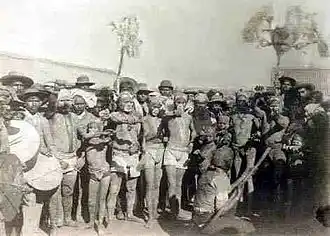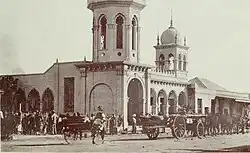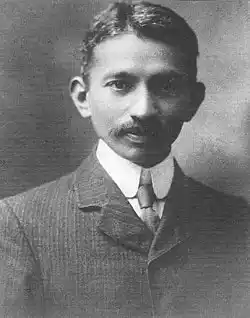
Indian South Africans are the community of people of Indian ancestry who live in the country of South Africa. This portion of the Indian diaspora has its roots in the system of indentured servitude which was established across the British Empire in the middle of the nineteenth century after slavery was prohibited in 1833. Between 1837 and 1917 approximately one and a half million people were transported from British India to other parts of the British Empire to work as indentured servants with little rights and for little remuneration. This system was extended to South Africa in 1860. In the half century that followed just over 150,000 Indian indentured servants were brought to South Africa, primarily to work on plantations in the province of Natal. The system was prohibited in 1911 owing to poor treatment of the indentured servants. The movement of these people formed the basis for the emergence of an Indian diaspora community in South Africa which is 1.7 million people strong today.[1]
Research your ancestors on MyHeritage
Indian South Africans chronology of eventsIndian South Africans chronology of events
There have always been connections between the various parts of the Indian Ocean, even long before the arrival of the European colonial powers here. For instance, Oman and other Arabian states engaged in trade and conquest of parts of eastern Africa as far south as Zanzibar and Mozambique hundreds of years ago. The genetic makeup of the peoples of the coastal regions of Madagascar indicates that these shores have been visited over the centuries by groups from as far afield as Yemen, India and Java in Indonesia. Nevertheless, the southernmost climes of Africa were still a bit too remote for even the most adventurous merchants or colonists and there was little contact between India and the region approximating to modern-day South Africa prior to the nineteenth century.[2]
That changed in the middle of the nineteenth century. Britain had come into possession of the Dutch Cape Colony during the Napoleonic Wars (c. 1799–1815) and the British government took over India from the English East India Company in the late 1850s following the Great Mutiny of 1857 in India. By then there was already an established pattern of transporting poor Indian men overseas to places like the Caribbean to compensate for the loss of cheap labor which had resulted from the prohibition of slavery across the British Empire in 1833. These Indian indentured servants were latter-day slaves in all but name. They were sent to work for very little wages overseas, had few freedoms and were exploited by their employers. The system of indentured servants was expanded to South Africa in 1860.[3]

Between 1860 and the cessation of the scheme in 1911 just over 150,000 Indian indentured servants were transported to the British colonies of southern Africa, which had not yet been formed into the Union of South Africa. Most were sent to the port of Durban in the Colony of Natal. There was a thriving sugar plantation industry here and many Indians were employed as indentured servants working in the fields. The system was ended a year after the Union of South Africa was formed in 1910.[4]
The Indian South African community was substantial by the early twentieth century and continued to grow thereafter, both through natural increase and as a result of further, more voluntary migration from India to South Africa. The Indian community faced persecution even after the end of the indentured servitude system. Separate rules were developed for people of Indian heritage or birth under the Apartheid laws which were introduced in the aftermath of the Second World War as the white minority sought to solidify their control over the country politically and economically. While black South Africans and Indian South Africans should have had much in common as a result of their collective marginalization by the white Afrikaner community, inter-communal relations were often very poor. In January 1949 the anti-Indian Durban Riots saw over 140 people killed in the city of Durban, more than a thousand injured and thousands of buildings either damaged or completely destroyed. Hence, the Indian experience in South Africa has often been fraught.[5]
Extent of migration of Indian indentured servants to South AfricaExtent of migration of Indian indentured servants to South Africa

Modern studies have come up with very precise figures for the number of Indian indentured servants who were transported to Natal province between 1860 and 1911. Records for the 384 ship journeys involved indicate that 152,184 Indians were brought to the South African colonies in this way, just under 400 on average per ship. These nearly all embarked from the ports of Madras and Kolkata in British India.[6] Of course, these were not the only Indians who ended up in South Africa during this period. Thousands of other Indian people migrated to South Africa as the Indian South African community grew. Most famously, Mahatma Gandhi arrived to South Africa in 1893 and spent the next 21 years living there, often acting as a lawyer for the growing Indian community and the persecution Indian people faced in the South African colonies.[7]
Demographic impact of Indian South AfricansDemographic impact of Indian South Africans
The long-term impact of the transport of Indian indentured servants to the South African colonies between 1860 and 1911 has been to create a substantial Indian diaspora community in modern South Africa. Although just over 150,000 Indians were brought to South Africa in this way between 1860 and 1911, natural increase has expanded that community and more people have arrived to South Africa from India in the twentieth and early twenty-first centuries, drawn by the fact that there was already an Indian community in the country. As of the 2022 national census, there are 1.7 million people of Indian heritage in South Africa. Moreover, they constitute a particularly substantial part of the population of the city of Durban and its wider hinterland in KwaZulu-Natal province.[8]
See alsoSee also
Explore more about Indian South AfricansExplore more about Indian South Africans
- South Africa, Dutch Reformed Church Registers, 1660-1970 records collection on MyHeritage
- South Africa, Methodist Parish Registers, 1822-1996 records collection on MyHeritage
- South Africa, Free State Dutch Reformed Church Records, 1848-1956 records collection on MyHeritage
- Boer War, Casualties, 1899-1902 records collection on MyHeritage
- South Africa, Orange Free States, Estate Files, 1951-2006 records collection on MyHeritage
- Apprentices, Indentured Servants, and Redemptioners: White Slavery in America at Legacy Family Tree Webinars
- Indentured Servitude in the Mid-Atlantic States at Legacy Family Tree Webinars
References
- ↑ http://www.sahistory.org.za/article/indian-indentured-labour-natal-1860-1911
- ↑ Neville Chittick, ‘Indian Relations with East Africa before the Arrival of the Portuguese’, in The Journal of the Asiatic Society of Great Britain and Ireland, No. 2 (1980), pp. 117–127.
- ↑ https://blog.nationalarchives.gov.uk/a-new-system-of-slavery-the-british-west-indies-and-the-origins-of-indian-indenture/
- ↑ http://www.sahistory.org.za/article/indian-indentured-labour-natal-1860-1911
- ↑ https://www.sahistory.org.za/article/1949-anti-indian-pogrom-durban
- ↑ https://www.sahistory.org.za/article/ship-list-indian-indentured-labourers
- ↑ Paul F. Power, ‘Gandhi in South Africa’, in The Journal of Modern African Studies, Vol. 7, No. 3 (October, 1969), pp. 441–455.
- ↑ https://census.statssa.gov.za/assets/documents/2022/P03014_Census_2022_Statistical_Release.pdf
